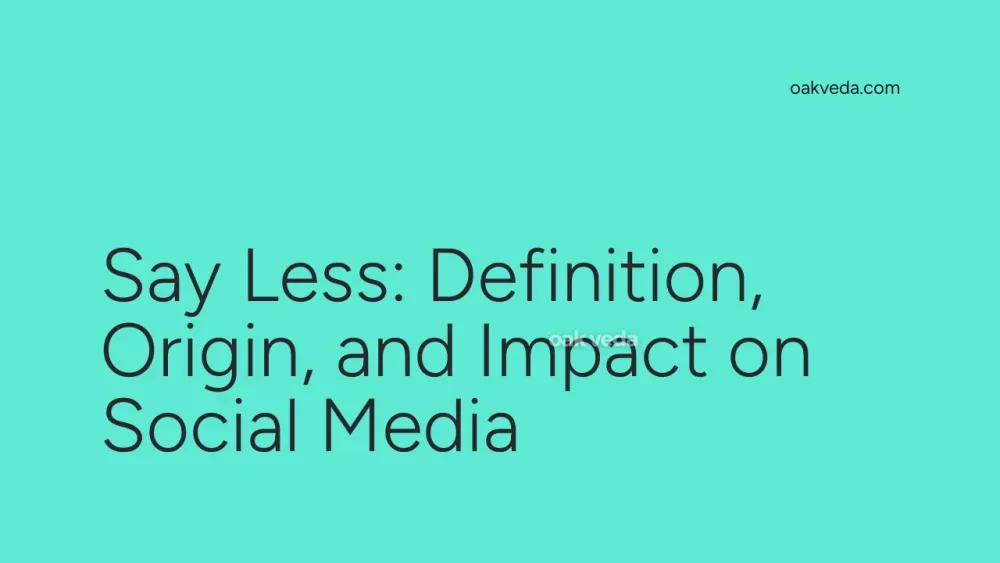
What is "Say Less"?
"Say less" is a popular slang phrase used extensively on social media platforms and in digital communication. It's a concise expression that conveys agreement, understanding, or encouragement to be more direct. In essence, "say less" means "I understand completely" or "You don't need to explain further." This phrase has become a staple in online conversations, particularly among younger generations.
Origin and Development of "Say Less"
The phrase "say less" originated in African American Vernacular English (AAVE), reflecting the cultural value of brevity and directness in communication. While its exact origin date is unclear, the term gained significant traction on social media platforms in the mid-2010s.
As with many AAVE expressions, "say less" has been adopted by mainstream internet culture, spreading across various social media platforms and becoming a part of the broader online lexicon. Its popularity can be attributed to its versatility and the increasing desire for quick, efficient communication in the digital age.
How "Say Less" Works
"Say less" functions as a multi-purpose phrase in online conversations:
- Agreement: It's often used to express strong agreement with someone's statement or proposal.
- Understanding: The phrase indicates that the speaker fully comprehends the situation or explanation.
- Encouragement for brevity: It can be used to suggest that someone should be more concise or direct in their communication.
- Ending a conversation: In some contexts, it serves as a polite way to conclude a discussion.
The beauty of "say less" lies in its simplicity and efficiency, allowing users to convey complex sentiments with just two words.
Popular Examples of "Say Less"
To better understand how "say less" is used in social media conversations, consider these examples:
-
Person A: "Want to grab coffee later?" Person B: "Say less! I'll meet you at 3."
-
Person A: "I'm thinking of dyeing my hair blue." Person B: "Say less, fam. It'll look amazing on you!"
-
Person A: "I can explain why I'm late..." Person B: "Say less. I get it, traffic was bad."
Impact of "Say Less" on Social Media Culture
The widespread adoption of "say less" has had several notable impacts on social media culture:
- Brevity in communication: It encourages users to be more concise and direct in their online interactions.
- Cultural exchange: As an AAVE term that's gone mainstream, it represents the ongoing influence of Black culture on internet language.
- Tone setting: The phrase can help establish a casual, friendly tone in digital conversations.
- Efficiency: It allows users to quickly acknowledge and respond to messages without lengthy explanations.
How Brands and Influencers Use "Say Less"
Savvy brands and influencers have incorporated "say less" into their social media strategies:
- Engagement: Using the phrase in responses to followers' comments to show understanding and agreement.
- Marketing campaigns: Some brands have created campaigns around the concept of "say less," emphasizing simplicity and directness.
- Product naming: The phrase has inspired product names or taglines in industries targeting younger demographics.
- Content creation: Influencers often use "say less" in their content to appear more relatable and in tune with current slang.
Future Trends Related to "Say Less"
As social media language continues to evolve, we can expect several trends related to "say less":
- Evolution of meaning: Like many slang terms, "say less" may develop new nuances or uses over time.
- Cross-platform adoption: The phrase may become even more widespread across different social media platforms and demographics.
- Integration into AI: Chatbots and AI assistants may incorporate "say less" to seem more human-like in their interactions.
- Potential backlash: As with any popular slang term, overuse might lead to it falling out of favor or being seen as cliché.
FAQs about "Say Less"
-
Is "say less" considered rude? Generally, no. In most contexts, it's a friendly and casual way to communicate. However, tone and context are important, as with any slang term.
-
Can "say less" be used in professional settings? It's best to avoid using "say less" in formal or professional contexts, as it's still considered casual slang.
-
Is "say less" only used online? While it's most common in digital communication, "say less" has also made its way into spoken language, especially among younger generations.
-
Are there any alternatives to "say less"? Yes, phrases like "got it," "I understand," or "no need to explain" convey similar meanings in a more formal tone.
-
How do you respond to someone who says "say less"? Usually, no response is necessary. If you want to acknowledge it, a simple "ð" emoji or "cool" would suffice.
In conclusion, "say less" has become a significant part of social media language, reflecting the evolving nature of online communication. Its popularity demonstrates the ongoing influence of AAVE on internet culture and the increasing value placed on brevity and directness in digital interactions. As social media continues to shape how we communicate, phrases like "say less" serve as interesting markers of linguistic and cultural evolution in the digital age.
You may be interested in:
- Doing It for the Gram: Definition, Origin, and Impact
- Link Tree: Definition, Origin, and Impact on Social Media
- Sliding into DMs: Definition, Origin, and Impact
- Slay: Definition, Origin, and Impact on Social Media Culture
- #XYZBCA: Definition, Origin, and Impact on TikTok
- Meme: Definition, Origin, and Impact on Social Media

